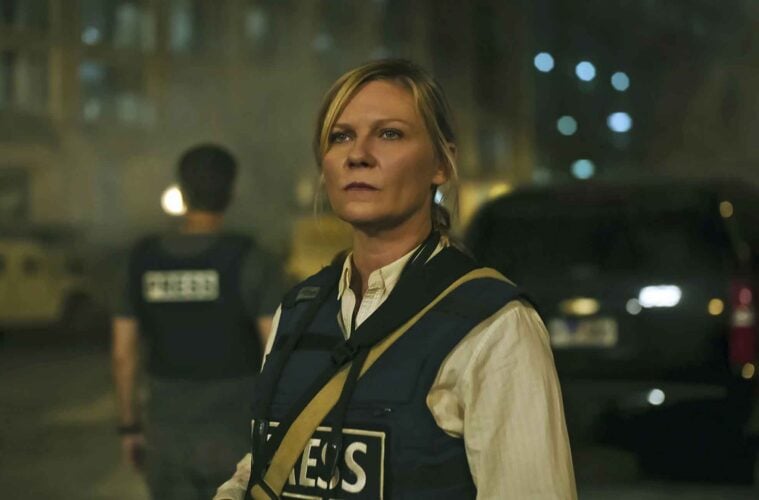
Alex Garland’s Civil War poses a big question: What if American democracy shattered into a million pieces and citizens were forced to fight the government for our basic rights? If you’ve been watching the news, you’ll realize it’s not a farfetched concept. Written and directed by Garland with an artistry that combines the documentarian grit of Costa-Gavras (Z, Missing) with the keen eye of Steven Soderbergh, Garland’s craftsmanship has an undeniable power that will force one to ask if America isn’t so different from other countries that have engaged in warfare to wrestle back power from intractable dictators.
Of course, the movie’s tricky subject matter makes one question if it’s the right time to release such a film. Then again, maybe the timing is perfect since America is as deeply divided along political and cultural lines as at any time since the actual Civil War of the 1860s. Well, there’s nothing to fear, Civil War is more of an abstract cautionary tale than a serious commentary. Garland’s raw and compelling portrait of societal breakdown unfortunately tries so hard to skirt real American politics (and history) it falls short of greatness. The “America” in this film doesn’t resemble the country we live in, even accidentally.
Set in a nondescript future towards the end of a second American civil war, the conflict itself is portrayed as riotous mayhem in the cities and random bloodshed in the suburbs and beyond. It’s also a take-no-prisoners death march: there are refugee camps in college football stadiums, dead bodies littering roadsides and hanging from freeway overpasses, and soldiers with tanks and jeeps parked at checkpoints as they inspect IDs and shoot “secessionists” on site. These government soldiers might be well equipped, but the country’s president (Nick Offerman) and the national capital are under threat from the “Western Forces,” an alliance led by California and Texas, who banded together to fight this war (yeah, right). Although Garland’s made a safe and understandable choice (partly by ignoring the current voting patterns of the allied states) it is one that usurps the underlying strength of the narrative. Don’t get me wrong: It’s a powerful film with wonderful performances and towering set pieces and worth a trip to the theaters, but how effectively Garland’s ideas blossom in the wake of all the deafening gunfire and explosions is debatable.
Essentially a road picture, the story follows four journalists as they drive from New York City to Washington D.C. to capture the fall of the empire. Our tour guides into this concrete hell include Lee (Kirsten Dunst), a burnt-out war photojournalist, her correspondent Joel (Wagner Moura), a bibulous scribe who gets high on the fumes of battle, their mentor Sammy (Stephen McKinley Henderson), and the overeager newbie, Jessie (Cailee Spaeny). Their camaraderie acts as the genuinely humane component in a world that’s gone to hell. Garland should try his hand at a purely character-driven piece because he’s gifted with writing incisive dialogue and framing interesting relationships. The heart of the film resides in the relationship between the two women as Lee instructs her protégé Jessie to be resilient in discovering the perfect image that will encapsulate history.
The best part of the movie lies in its angular style, not in its messaging. Although it’s a dark fantasy, the daily grind of war feels real. Whether our protagonists are caught in a crossfire in an abandoned building, witnessing sharpshooters engage in a firefight with a sniper, or passing through a small town where shops are still open and purveyors live in denial, Garland creates a tense, unpredictable atmosphere. There’s a particularly frightening sequence involving Jessie Plemmons as one of the government soldiers, which is the most formidable moment in the movie and should’ve intuited a little more about America’s ongoing real-life issues, but simply doesn’t.
Although Garland flirts with the idea of a Trumpian dictatorship, the narrative never hints that there is a red versus blue mentality in this country, which is like saying we live on Mars. One wishes Garland could’ve sprinkled some political truths in the narrative without going overboard instead of hiding in a bunker of fantasy. Of course, his intent is for the audience to feel the effects of war, especially in a country that’s been clothed and fed and protected for so long. Who really cares how it started? Still, when a movie completely discards the history of a country it purports to be about, all the combat in the world can’t force one to emotionally connect with it. Ultimately, the film’s intellect is baked into its concept more than its narrative.
What is undeniable is the film’s craftsmanship. Propelled by a throbbing soundtrack with songs by Suicide and De La Soul Civil War is not only a tightly paced thriller but a passionate defense of journalism. Actually, Garland’s take on the importance of the press is the film’s most provocative theme, which, ultimately, isn’t that confrontational in a movie about a domestic conflict. But the movie does beg the question: How does one tell the story of another American civil war without addressing its most fundamental issues? Well, you filter it through science fiction, a genre Garland mastered since his inception as an artist. From 2002’s 28 Days Later to Annihilation (2018), Garland works within parable and metaphor more than reality. His newest takes chances by stylistically toeing the line between the two. It’s a compelling piece of work with unforgettable imagery and a menacing, dark tone. Still, a little political and historical reality would’ve gone a long way in engaging its audience in a dialogue that goes beyond, “War is hell.” ❖
Advertising disclosure: We may receive compensation for some of the links in our stories. Thank you for supporting LA Weekly and our advertisers.

